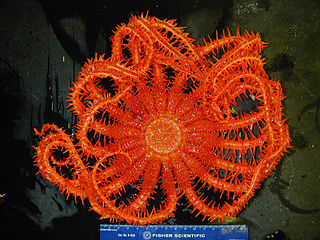
The Valvatida are an order of starfish in the class Asteroidea, which contains 695 species in 172 genera in 17 families.

The Asterinidae are a large family of sea stars in the order Valvatida.

Astropecten is a genus of sea stars of the family Astropectinidae.

Astropecten polyacanthus, the sand sifting starfish or comb sea star, is a sea star of the family Astropectinidae. It is the most widespread species in the genus Astropecten, found throughout the Indo-Pacific region. The armspread is up to 20 cm (8 in). The specific epithet "polyacanthus" comes from the Latin meaning "many thorned".

The Asteriidae are a diverse family of Asteroidea in the order Forcipulatida. It is one of three families in the order Forcipulatida.

The Paxillosida are a large order of sea stars.

Goniasteridae constitute the largest family of sea stars, included in the order Valvatida. They are mostly deep-dwelling species, but the family also include several colorful shallow tropical species.

Psilaster andromeda is a species of starfish in the family Astropectinidae. It is native to the northeastern Atlantic Ocean where it occurs at abyssal depths.

The Oreasteridae are a family of sea stars in the class Asteroidea.

Astropecten irregularis is a sea star of the family Astropectinidae. Common names include Sand sea star.

Solaster is a genus of sea stars in the family Solasteridae.

Archaster typicus is a species of starfish in the family Archasteridae. It is commonly known as the sand star or the sand sifting star but these names are also applied to starfish in the genus Astropecten. It is found in shallow waters in the Indo-Pacific region.

The Brisingidae are a family of starfish found only in the deep sea. They inhabit both the Atlantic and Pacific Oceans at abyssal depths, and also occur in the Southern Ocean and around Antarctica at slightly shallower depths.

Psilaster is a genus of sea stars of the family Astropectinidae.
Trophodiscus almus is a species of starfish in the family Astropectinidae. It is found in fairly deep waters in the Sea of Okhotsk, the Sea of Japan and around the Japanese island of Hokkaido. It is very unusual among starfish in that it broods its young on its upper surface. Its common name in Japanese is "Komochi-momiji".
Trophodiscus is a genus of starfish in the family Astropectinidae. There are only two species, both found in fairly deep waters in the Sea of Okhotsk. Trophodiscus almus is also found in the Sea of Japan and around the Japanese island of Hokkaido. These starfish are very unusual in that the young are brooded on the upper surface of the female.

Pterasteridae is a family of sea stars in the order Velatida, consisting of eight genera.
Pseudarchaster is a genus of echinoderms belonging to the family Pseudarchasteridae.

Tethyaster is a genus of echinoderms belonging to the family Astropectinidae.

Dytaster is a genus of echinoderms belonging to the family Astropectinidae.






























